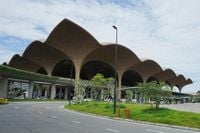Cambodia has ushered in a new era for its aviation industry and national development with the official inauguration of Techo International Airport, a sprawling, multi-billion-dollar facility that now serves as the country’s primary gateway to the world. The grand opening ceremony, held on Monday, October 20, 2025, was presided over by Prime Minister Hun Manet, who called the airport a "catalyst for Cambodia's economic and tourism growth" and a key driver for attracting both investors and visitors (as reported by AP and Economic Times).
Located in Kandal province, about 30 kilometers south of Phnom Penh, Techo International Airport replaces the nearly 70-year-old Phnom Penh International Airport, which has now been completely closed. The new airport began operating in September and represents a joint venture between the Cambodian government and the Overseas Cambodian Investment Corporation (OCIC), according to multiple sources including International Airport Review and Economic Times.
The scale of the project is impressive by any measure. With a reported investment of between $2 billion and $2.3 billion, the airport boasts three runways—an enormous leap from the single runway of its predecessor. The dual 4-kilometer runways are designed to accommodate long-haul international flights and all types of aircraft, supporting Cambodia’s ambitions to become a more competitive player in the global aviation market. Construction began in 2020, with China State Construction Engineering Corporation serving as the primary contractor, as highlighted by International Airport Review and AP.
Prime Minister Hun Manet, at the inauguration, expressed optimism for the future: "I'm confident that the TIA will become a catalyst for Cambodia's economic and tourism growth, helping attract more investors and tourists." He added that the new hub would significantly boost both passenger travel and cargo transport capabilities, strengthening Cambodia's regional and global connectivity (as quoted by AP and Economic Times).
The airport’s capacity is equally forward-looking. Initially, it can handle 13 million passengers annually, a figure expected to rise to 30 million after 2030 and up to 50 million by 2050, according to projections cited by both AP and Economic Times. These expansion plans come at a time when Cambodia is eager to recapture and surpass its pre-pandemic tourism numbers. In 2024, the country received 6.7 million foreign tourists—a 23% increase from 2023—and about 4 million tourists from January through August 2025 alone, as Prime Minister Hun Manet noted in September.
The airport is not just about numbers, though. It’s also about experience. The newly opened Plaza Premium First (PPF) and Plaza Premium Lounge (PPL) at Techo International Airport, launched by the Plaza Premium Group (PPG), aim to set a new standard for comfort and hospitality. The PPF lounge offers space for 110 customers and features Cambodian cultural motifs, artwork by Bill Bensley, and handcrafted cocktails made with local ingredients. The PPL lounge, with a capacity of 120, serves authentic Cambodian dishes like Beef Lok Lak and Fish Amok, and greets guests with ambassadors dressed in the traditional Sampot (as reported by Travel Radar).
PPG’s Regional General Manager for Southeast Asia, Cavin Loh, emphasized the strategic importance of the new lounges: “The opening of Plaza Premium First and Plaza Premium Lounge in Phnom Penh reflects Plaza Premium Group’s global direction of expanding our award-winning airport hospitality services into key international gateways. Cambodia’s Techo International Airport represents a critical hub in the region and offers exciting opportunities for PPG, given the airport’s expansion plan with two additional runways to be completed in phases, passenger capacity is expected to reach 45 million by 2050.” PPG, which operates in 150 countries across 600 airports, has been recognized with the ‘World’s Best Independent Airport Lounge’ award from Skytrax for nine consecutive years, from 2016 to 2025.
Beyond the glitz and glamour, however, the airport’s debut comes amid notable challenges. The immediate prospects for a surge in foreign tourists have been overshadowed by negative headlines, including the highly publicized death of a young South Korean man who was reportedly lured into Cambodia’s online scam centers—illegal operations where workers are kept as virtual slaves to conduct online fraud, a multi-billion-dollar organized crime activity. The international spotlight on this issue intensified last week when the United States and Britain imposed sanctions on organizers of a major Cambodian gang, and a federal court in New York indicted its alleged ringleader (as reported by AP and Economic Times).
Tourism also took a hit in July 2025, when Cambodia and neighboring Thailand engaged in a five-day conflict that, while ultimately halted by a ceasefire, left tensions high in the region. These incidents have cast a shadow over Cambodia’s efforts to position itself as a safe and attractive destination for international travelers and investors. Still, the government remains hopeful. Prime Minister Hun Manet stated that he hopes the new airport will be a “driving force in attracting more tourists and investors to Cambodia, more than before the arrival of COVID-19.”
Techo International Airport is Cambodia’s second major new airport in just two years. In October 2023, the Siem Reap-Angkor International Airport was opened to serve the country’s top tourist attraction, the centuries-old Angkor Wat temple complex. With the addition of Techo International, Cambodia now boasts three operational international airports, a significant expansion of its aviation infrastructure.
The new airport’s opening has been supported by a range of organizations, including the Overseas Cambodian Investment Corporation (OCIC), and features modern infrastructure designed to enhance passenger experience, sustainability, and route development. According to International Airport Review, the airport’s design and construction have focused on supporting tourism, trade, and long-term economic growth—not just for Cambodia, but for the entire region.
As Cambodia continues to modernize and expand its transportation network, the Techo International Airport stands as a bold symbol of its ambitions. The hope is that, despite the headwinds of crime and regional instability, the country’s newest aviation hub will help propel Cambodia into a new era of prosperity, connectivity, and global engagement.
For Cambodia, the journey is just beginning. With Techo International Airport now fully operational, the world is just a little bit closer to Phnom Penh—and, perhaps, to the future Cambodia envisions for itself.


